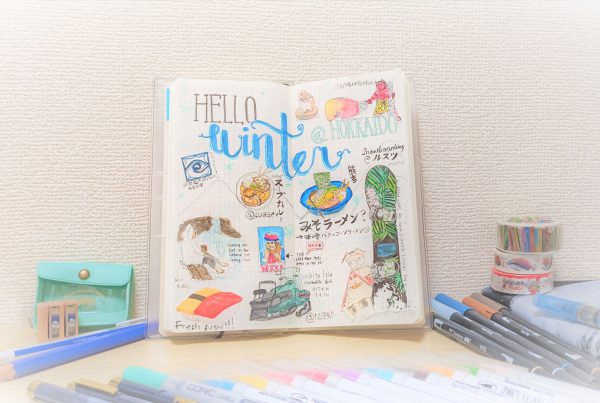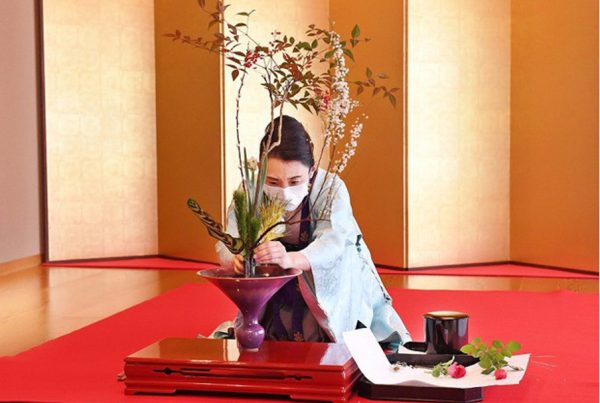Every year, people from all over the world would relocate to Japan for various reasons. Some people are expatriated to Japan on business, while some others opt to further their education in Japan. No matter the reason, moving to a new country is indeed a challenge. Especially if one is not familiar with the weather and the language.
Summer in Japan is very humid at over 80% humidity in the air depending on the location. During the rainy season in June (also known as Tsuyu, 梅雨), humidity level increases rapidly. One big challenge many people face (not just international people, but the Japanese as well) is the issue of mold and mildew growth at home.
Mold, also known as kabi (カビ) in Japanese, is a common challenge faced in Japan. As with everywhere in the world, mold thrives in places with high moisture. It only gets worse during the rainy season, especially if you experience leaking roof or even pipes.
Frequent exposure to mold might lead to mold allergy. According to Mayo Clinic, some common allergic reactions are sneezing, runny nose, watery eyes and itchy skin. The symptoms are similar to dust allergy, hence the difficulties in detecting it. It could potentially trigger asthma attacks too.
Best Condition for Mold and Mildew Growth
Just like the requirements for human survival, mold has 3 important conditions to be met for it to thrive.
1) Humidity at 60% of more
2) Optimum temperature between 25 - 28 degrees (but it could grow between 20 - 40 degrees or higher)
3) Availability of nutrients (e.g. sebum, hair, dust, dust mite, etc.)
There are many parts of your house that will be affected by mold. The common ones are the bathroom, toilet, kitchen and the washing area.
The bathroom is a great place for mold to thrive as it satisfies all 3 abovementioned conditions. To avoid this problem, it is best to manage the humidity of home at about 50% and to keep the exhaust fan turned on at all times especially in the bath area.
Should you already have mold in your house, there are some simple homecare products you could use to manage the situation. And if you are living in Japan, it is relatively easy to get these homecare products.
The Bathroom
Generally, one would find two challenges in the bathroom. The first being the black mold, and the second being biofilm (the pinkish-looking slime that grows quickly).
The “pink slime” in the bathroom is not mold. Rather, it is a type of “biofilm” (i.e. colony of bacteria, Serratia marcescens) that thrives best in the bath, feeding off the mineral and fatty deposits from soap scum. While the “pink slime” is not as bad as the toxic black mold, you would probably want to scrub the bath as often as you can. Don’t forget the bath curtain too!
There are many products on sale in Japan that caters to your bathroom care needs. The easiest being the spray bottles widely sold everywhere in Japan.
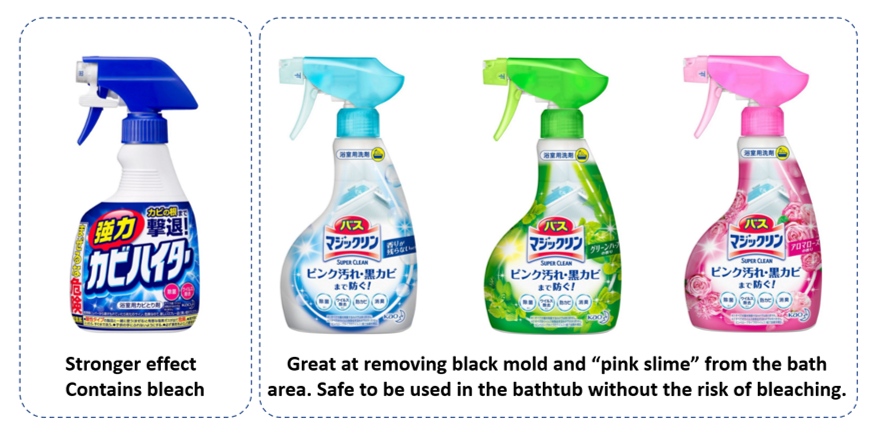
Example of Kao MagicClean’s foaming spray range. Image via Kao website.
Mold on rubber is one of the toughest to remove. But luck is on your side if you could get your hands on some of these items. The gel type is best under such circumstances. Be careful not to scrub too hard, as the scratches on the soft surface of the rubber makes it easier for mold to multiply.
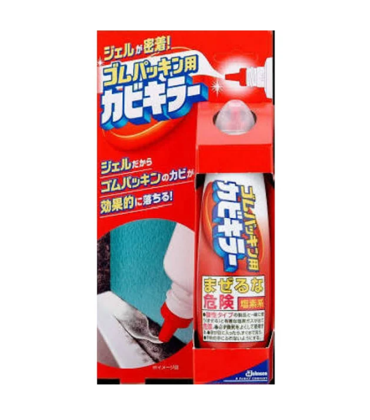
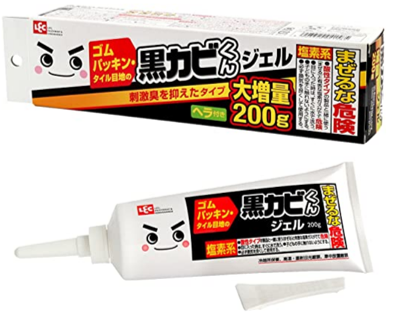
Image via Amazon Japan
Should you have tiles in your bathroom, consider using the gel format to remove mold! Apply the gel between tiles and let it sit for approximately 30 minutes (depending on the product used).
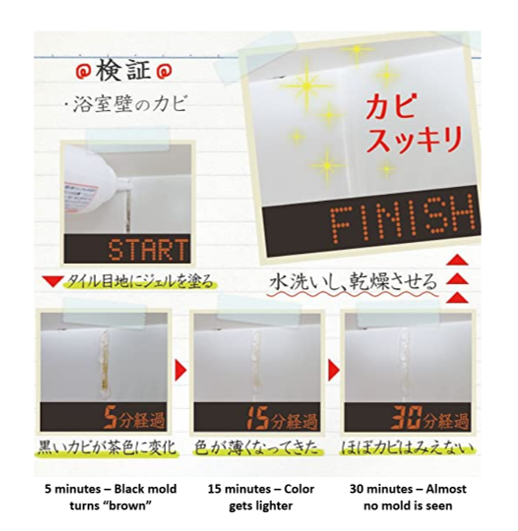
Image via Amazon Japan
For some, prevention is better than cure. In this sense, Japan has you covered. Another interesting product commonly used in Japan is this: the bath anti-mold fogging product, otherwise known as “ofuro no boukabi” in Japanese (おふろの防カビくん煙剤).
This product is released as “fog” (or smoke, if you like) that coats the bathroom with a nano-silver coating which is antibacterial and antimicrobial. There is only one important pre-requisites to using this: the bathroom has to be properly cleaned and scrubbed to gain maximum effect.
For more information on how to use this product, realestatejapan has released an informative article in English on the step-by-step process.
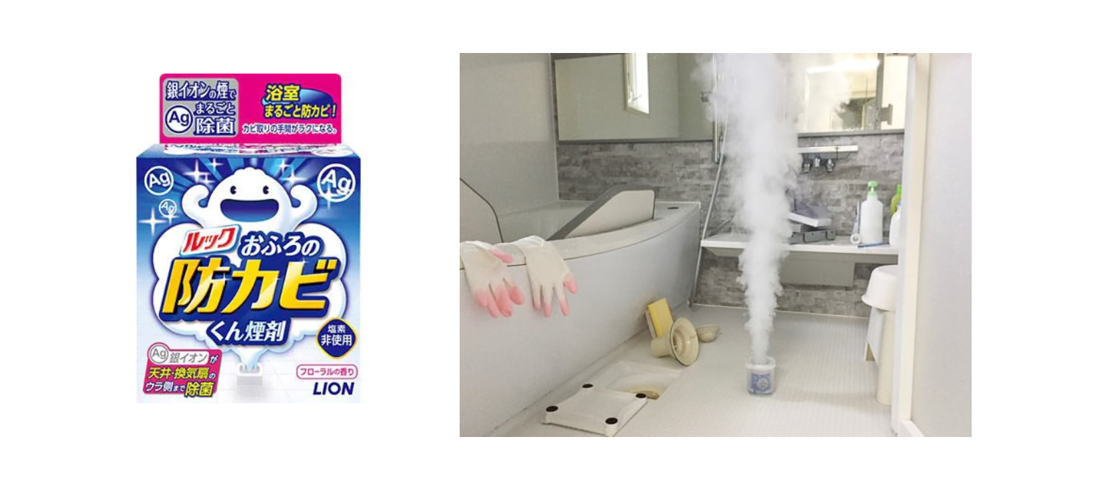
Image source: Lion Japan (left), Sumaiweb (right)
Tatami – The “Must Have” in Japanese Homes
When one mentions “a typical Japanese home”, what is the one common feature that comes to most peoples’ mind? You might have probably guessed it right – The tatami! Tatami is made of rice straw, and rush (also known as igusa in Japanese). You can find out more about tatami in this well-detailed article by Motoyama Tatami Shop in Kyoto.
An article by Tokyo Life weighs the pros and cons of having the tatami, highlighting mold as one of the biggest challenge in maintaining tatami in the house. It is no wonder why the younger generation are proactively selecting accommodations without a tatami room! All hope is not lost, though, should you have a tatami or you are interested in living in a place with tatami.
What causes mold to grow on tatami?
The top 3 reasons why mold grows on tatami:
1) Insufficient ventilation
2) Rush, the top layer, absorbs moisture
3) Laying a futon on the tatami
How should one take care of the tatami, then? The best way is to ensure the room is well-ventilated. One might also notice that new tatami absorbs moisture better, hence mold would grow more easily as compared to older tatami (with the rush layers drying out over the years). Futon laid on the tatami should be removed everyday to avoid moisture trapped between the futon and the tatami. If possible, air the futon often.
When noticing mold on the tatami, do not use water or dry cloth to clean. Instead, consider using a 7:3 mixture of rubbing alcohol (with 70 – 80% alcohol) and purified water. Put it in a spray bottle and spray it on the tatami mat. Leave it for 20 minutes, and use an old toothbrush to scrape out the mold.
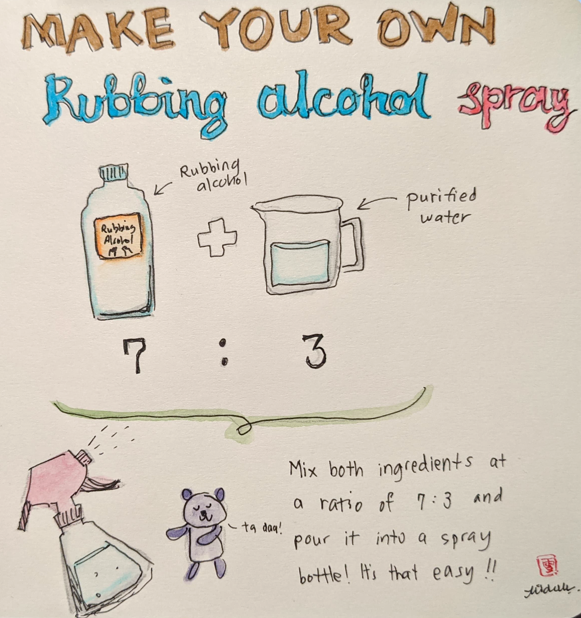
Making the rubbing alcohol spray solution is simple. Illustration by the author.
Mold can also be managed using baking soda. It is best to clean it as often as possible to avoid having to pay the experts for a thorough clean. Do not use mold remover sprays as it might cause discoloration of the tatami mats.
Always keep the room ventilated while cleaning.
Mold Loves Your Futon!
The mere thought of seeing mold on one’s futon is the best way to keep people out of bed. The problem is, mold is invisible to the naked eye until Why would mold grow on futon, one might wonder? On a sweltering night in summer, it is only natural for people to sweat. Futon does its magic by absorbing sweat and moisture. As such, it is important to air the futon out often. If not, mold and mites thrive best under such condition.
The best way to manage is by airing the futon outside. The UV rays from sunlight kills mold and mites. Best thing, you do not have to pay for the sunlight. However, not every day is a sunny day. If drying the futon in the sun is not an option, another way is to dry the futon indoors by ventilating the room while leaning the futon on the floor or against the wall. Some people would consider flipping the futon more often, but there is a limit to this trick.
If you are willing to spend and you have some space at home for another gadget, consider getting a futon dryer (futon kansouki, ふとん乾燥機).
Price varies depending on the ease of use, warming speed, quietness, as well as additional features. Some of the higher-end ones offer tick countermeasures, or even clothes drying function. You can use this dryer to dry your shoes too during the rainy days!
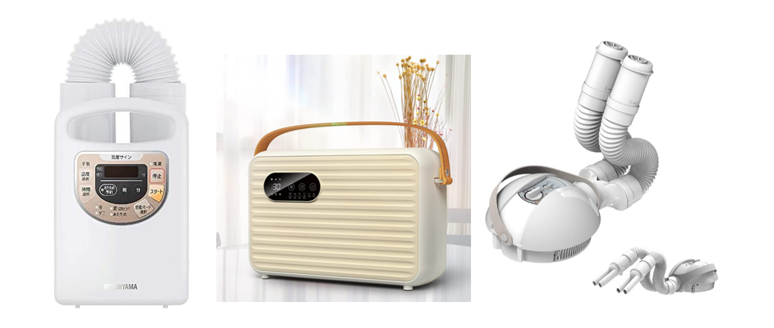
Example futon dryers from multiple brands available. Image via Amazon Japan
Kitchen: The Treasure Trove for Mold
The kitchen is a great place for mold to thrive, with food and oil deposits in abundance. If you are considering something more eco-friendly, baking soda is your best buddy. Baking soda is a weak alkaline and safe to be used . With its ability to remove odor, dissolve dirt and grease easily in water for effective removal, baking soda is a must-have on one’s list of items. The best part is, baking soda can be found easily everywhere around the world!
How do you make your own baking soda spray solution? It is pretty simple, just like the image below!

Add 1/2 teaspoon of baking soda to 200ml warm water at 40 degrees (celcius). Illustration by the author.
If you have a hard time looking for it, mention the word “juso” (重曹) to the staff at the supermarket and they will guide you to the product. In Japan, you also have the option of choosing the spray version for ease of use.
Another alternative is sodium sesquicarbonate, also known as “sesuki tansan soda” in Japanese (セスキ炭酸ソーダ). This option is more soluble in water and stronger against grease.
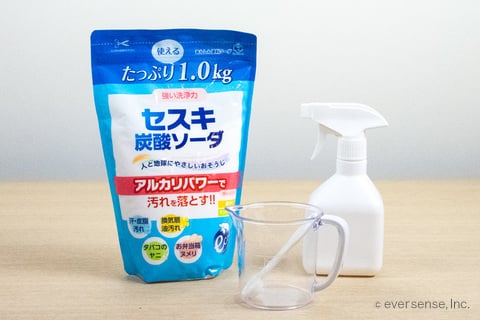
Sodium sesquicarbonate is a good alternative. Image via CojiCaji website.
Baking soda is great for cleaning the kitchen top, the stove, the sink and even plastic cutting boards. But do be aware that using baking soda on aluminum for a long time causes oxidation, and it is not recommended to be used on wood as well.
As with most cleaning products, protect your hands with gloves when using both baking soda and sodium sesquicarbonate or risk having dry and rough skin!
In Conclusion
Mold and mildew growth is something natural and unavoidable in life. One can only do their best to manage the growth of the mold and mildew by consistently cleaning the house, and to manage the humidity level in the house.
The Japanese air-conditioners in general has a drying function listed as either “joshitsu” (除湿) or the “dorai” (ドライ) function. Alternatively, you could get a dehumidifier and plug it in. This option saves more electricity than the air-conditioner. But the downside is, there will be an extra item in your house.
Japan has many products and options available for users in general, but it does take a lot of reading and testing out the product to actually know if it is useful. One good way is to take some time to browse the homecare section in the drugstore or the supermarket, while another option is to rely on Google or help from friends. While language might be a barrier, knowing some keywords would help you in the long run to seek for better products.
All the best in hunting for cleaning products to keep the mold out and stay healthy in a clean home!
P/S: If you are looking for some great tips on cleaning, head over to Kao‘s page for some inspiration!
Main image: Licensed from Adobe Stock









